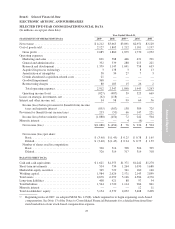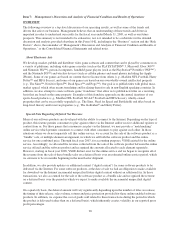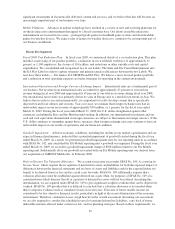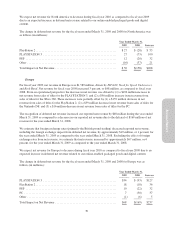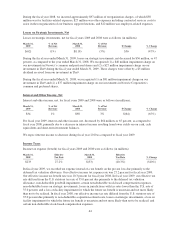Electronic Arts 2009 Annual Report Download - page 114
Download and view the complete annual report
Please find page 114 of the 2009 Electronic Arts annual report below. You can navigate through the pages in the report by either clicking on the pages listed below, or by using the keyword search tool below to find specific information within the annual report.SFAS No. 142 requires a two-step approach to testing goodwill for impairment for each reporting unit annually,
or whenever events or changes in circumstances indicate the fair value of a reporting unit is below its carrying
amount. Our reporting units are determined by the components of our operating segments that constitute a
business for which both (1) discrete financial information is available and (2) segment management regularly
reviews the operating results of that component. SFAS No. 142 requires that the impairment test be performed at
least annually by applying a fair-value-based test. The first step measures for impairment by applying fair-value-
based tests at the reporting unit level. The second step (if necessary) measures the amount of impairment by
applying fair-value-based tests to the individual assets and liabilities within each reporting unit.
To determine the fair values of the reporting units used in the first step, we use a combination of the market
approach, which utilizes comparable companies’ data, and/or the income approach, or discounted cash flows.
Each step requires us to make judgments and involves the use of significant estimates and assumptions. These
estimates and assumptions include long-term growth rates and operating margins used to calculate projected
future cash flows, risk-adjusted discount rates based on our weighted average cost of capital, future economic
and market conditions and determination of appropriate market comparables. These estimates and assumptions
have to be made for each reporting unit evaluated for impairment. Our estimates for market growth, our market
share and costs are based on historical data, various internal estimates and certain external sources, and are based
on assumptions that are consistent with the plans and estimates we are using to manage the underlying business.
Our business consists of developing, marketing and distributing video game software using both established and
emerging intellectual properties and our forecasts for emerging intellectual properties are based upon internal
estimates and external sources rather than historical information and have an inherently higher risk of accuracy.
If future forecasts are revised, they may indicate or require future impairment charges. We base our fair value
estimates on assumptions we believe to be reasonable but that are unpredictable and inherently uncertain. Actual
future results may differ from those estimates.
Assessment of Impairment of Short-Term Investments, Marketable Equity Securities and Other Investments. We
periodically review our short-term investments, marketable equity securities and other investments for
impairment. Our short-term investments consist of securities with remaining maturities greater than three months
at the time of purchase and our marketable equity securities consist of investments in common stock of publicly
traded companies, both are accounted for as available-for-sale under the provisions of SFAS No.115, Accounting
for Certain Investments in Debt and Equity Securities, as amended. Unrealized gains and losses on our short-term
investments and marketable equity securities are recorded to other comprehensive income, net of tax, until either
(1) the security is sold or (2) we determine that the decline in the fair value of a security to a level below its cost
basis is other-than-temporary. Determining whether the decline in fair value is other-than-temporary requires
management judgment based on the specific facts and circumstances of each security. The ultimate value realized
on these securities is subject to market price volatility until they are sold. We consider various factors in
determining whether we should recognize an impairment charge, including the duration that the fair value has
been less than the cost basis, severity of the impairment, reason for the decline in value and potential recovery
period, the financial condition and near-term prospects of the investees, and our intent and ability to hold the
investment for a period of time sufficient to allow for any anticipated recovery in market value. During the fiscal
year ended March 31, 2009 and 2008, we recognized impairment charges of $57 million and $109 million,
respectively, on our marketable equity securities. We did not recognize any impairment charges on our
marketable equity securities during the fiscal year ended March 31, 2007. Our ongoing consideration of these
factors could result in additional impairment charges in the future, which could have a material impact on our
financial results.
Our other investments consist principally of non-voting preferred shares in two companies whose common stock
is publicly traded and are accounted for under the cost method as prescribed by Accounting Principles Board
(“APB”) No. 18, The Equity Method of Accounting for Investments in Common Stock, as amended. We monitor
these investments for impairment and make appropriate reductions in the carrying values if we determine that an
impairment charge is required, based primarily on the financial condition and near-term prospects of the
investees. During the fiscal years ended March 31, 2009 and 2008, we recognized impairment charges of $10
million and $9 million, respectively, on our other investments. We did not recognize any impairment charges
during the fiscal year ended March 31, 2007.
34





